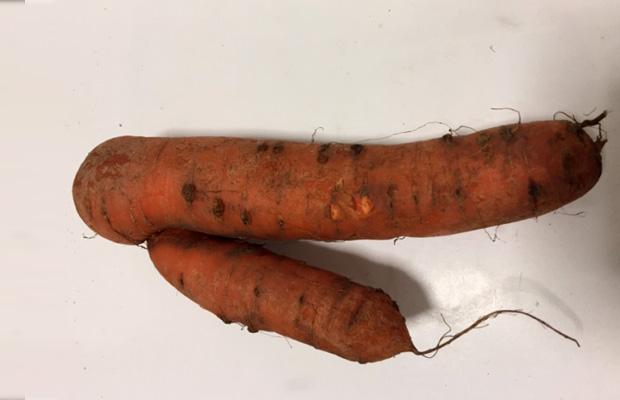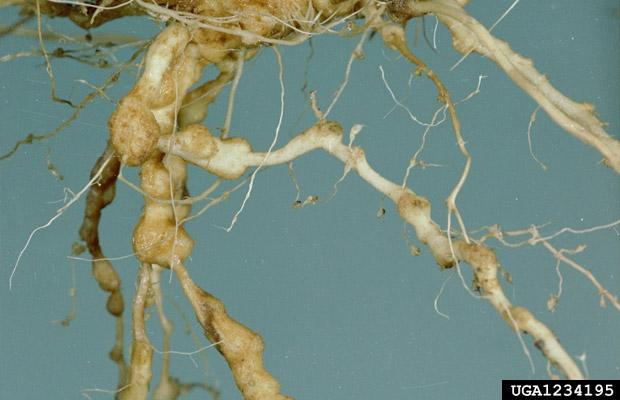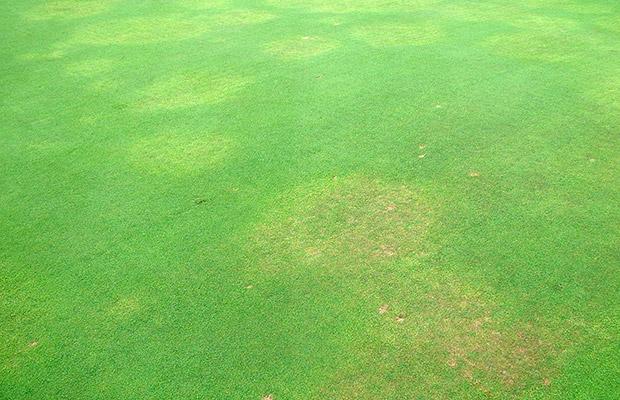It is closely related to a number of other root knot nematode species including M. chitwoodi and M. minor.
Threat
Meloidogyne fallax is a direct threat to a range of arable crops, protected crops, pasture and sports turf. The nematode has been detected in England and the Republic of Ireland and represents a current threat to Northern Ireland.
Susceptible species
This polyphagous pest has a wide host range including: potato, beet, carrots, turfgrasses, strawberries, lettuce, lucerne, tomato and black salsify.
Spread
M. fallax is spread on infected plant material, in soil and on contaminated machinery or footwear
Outbreak stage and national plans
For current advice see :
Preventing introduction and spread on sportsturf
Possible pathways for the introduction of nematodes into sports turf include the soil/sand/compost used to form the growing media, ready grown-turf, machinery or footwear. Grass seed is unlikely to be infested with Meloidogyne species and so is low risk. Some risk reduction measures include ensuring:
- Growing media is nematode free.
- Sand for use on sports turf is stored uncovered and weed free for at least nine months, preferably longer before use. This is likely to kill emerging juveniles. An alternative would be to use kiln dried sand.
- Compost used as part of growing media has been composted at a temperature sufficient to kill nematodes.
- Footwear is cleaned before and after use on sports pitches.
- Any machinery that has soil attached should be thoroughly power washed before it is moved between sites.
- Waste turf, topsoil and/or sub-soil (with the exception of grass cuttings) from sports pitches, especially those where nematode damage is suspected, should not be disposed of on agricultural land.
- Work on infested or potentially infested areas that may result in the transfer of soil is undertaken towards the end of the day, following work on other areas.
- If M. fallax is confirmed as being present, waste disposal controls and bio security measures will be required under a statutory plant health notice.
Distribution
Since it was described in the Netherlands in 1996, the nematode has also been recorded in South Africa, Australia, New Zealand, Chile and several European countries, including the UK, Ireland Germany, Belgium, France and Switzerland.
Symptoms

In sportsturf, root damage may cause areas of weak yellowing turf.


Reporting suspect cases
See contact information below.
Management, grants, treatment
See contact information below.
The science
See contact information below.
Origins
In the United Kingdom, Meloidogyne fallax (EPPO A2 List) was first reported in 2011 (in England) when it was found in sports turf. In 2013, another outbreak was found in a leek crop in Staffordshire on which M. fallax caused considerable stunting (outbreak currently under eradication). In October 2015, new outbreaks were reported in Northwestern England in sports turf at 3 different locations within approximately 15 km of each other. These outbreaks were discovered when damaged areas were noted in the turf and samples were sent to a diagnostic laboratory (morphological and DNA sequencing techniques). Two outbreaks were found in dense urban areas on brownfield sites, and one outbreak was found in a rural area surrounded by agricultural land (arable crops). The total infested area is under investigation but it is estimated to cover more than 5 ha. It is noted that all 3 infested sites have used the same main contractor to build and maintain the sports grounds. A containment strategy is in place to prevent the spread of M. fallax from the currently infested sites onto agricultural land. Guidance will be provided through relevant organizations responsible for sports turf, to encourage good practice and to help determining whether M. fallax could be present in other sports sites. It is noted that more than 30 other sites of sports turf across Great Britain have been tested over the last few months but M. fallax has not been found.The UK outbreaks may be linked to trade in vegetables and subsequent compost production. The turfgrass outbreak may be linked to movement of contaminated machinery and soil during pitch construction and maintenance. It is also possible that M. fallax is an emerging native pest in the British Isles.
Pest risk analysis
N/A
Import & movement restrictions
Meloidogyne fallax is an EU regulated root-knot nematode.
Further information
For additional information on UK Plant Health please see:
- https://secure.fera.defra.gov.uk/phiw/riskRegister/
- https://www.gov.uk/plant-health-controls
- Root Knot Nematodes Information Leaflet
Questions and answers
If M. fallax (or M. chitwoodi) has been confirmed to be present following laboratory analysis or there is a strong suspicion that M. fallax is present, the finding(s) must be reported to the relevant authority.
For Northern Ireland, contact:
Plant Health Inspection Branch
DAERA Northern Ireland
Tel: 0300 200 7847
Email: planthealth@daera-ni.gov.uk
